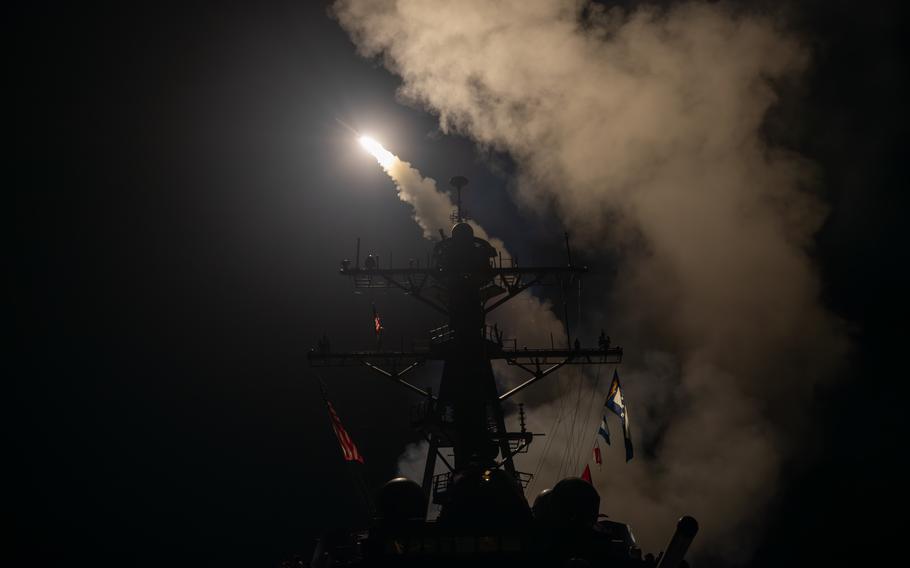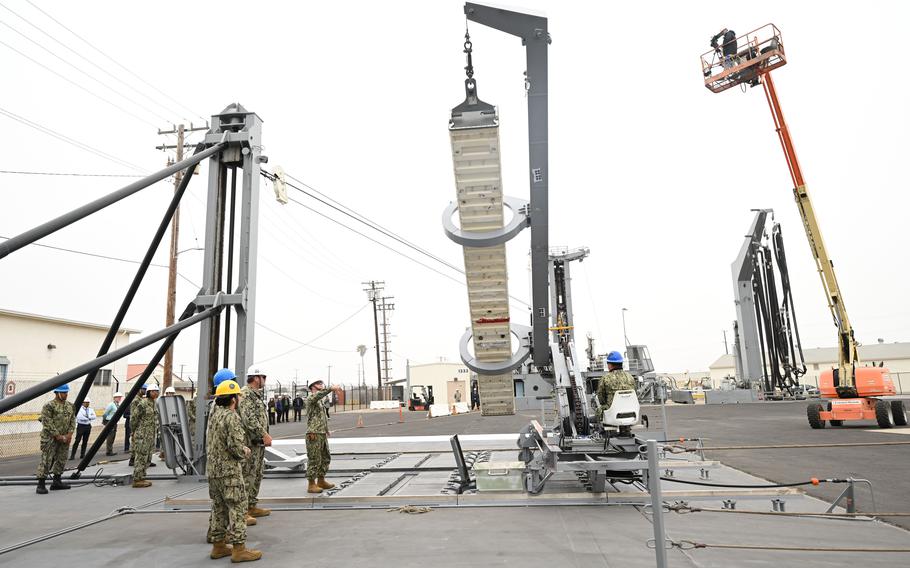
The destroyer USS Gravely launches Tomahawk missiles Jan. 12, 2024, in response to Houthi rebel attacks in the Red Sea. The Gravely was one of seven Navy ships that received a combat action ribbon in April for performance under fire in the Middle East. (Jonathan Word/Navy)
WASHINGTON — The Navy is one step closer to rearming ships at sea, a capability that would keep warships in the fight rather than forcing them to return to port during combat.
The first successful land-based demonstration of the Transferrable Rearming Mechanism, or TRAM, was announced Wednesday by the Naval Surface Warfare Center in Port Hueneme, Calif. The system will enable Navy destroyers and cruisers to reload missiles into vertical launching systems while at sea — a task that now must be done pier side.
“No longer will our combatants need to withdraw from combat for extended periods to return for vulnerable in-port reloading of weapon systems. ... My intention is to perfect this capability and field it for sustained, persistent forward-strike capacity during wartime,” Navy Secretary Carlos Del Toro said during a speech at Columbia University in December 2022, one of his earliest mentions of the new technology.
The rearming mechanism uses a crane that can lift and rotate 25-foot missile canisters vertically, then lowers the explosives into the launchers, which are small openings in the ship deck. The system is designed to be used with existing at-sea replenishment ships and will be able to reload vertical launch systems on surface ships in sea states 3 or higher. A sea state 3 means winds of 7-10 knots and 2-foot waves, according to the Beaufort Scale, a measure that estimates wind speed and its effects based on observed sea or land conditions.

Sailors from the Naval Expeditionary Logistics Support Group and USS Chosin (CG 65) guide a missile canister using the U.S. Navy’s Transferrable Rearming Mechanism as they demonstrate the ability to reload a Vertical Launching System cell on July 11 at Naval Surface Warfare Center, Port Hueneme Division’s Underway Replenishment Test Facility. (Navy)
Operationally, reloading in the open ocean would allow the U.S. surface fleet to engage enemy ships with a “relentless tempo and volume of long-range salvos,” Navy officials said Friday. Additionally, it means adversaries won’t be able to home in on U.S. ships at friendly ports, widening the area that an adversary must search to target them.
“This prospect will disrupt the strategic calculus of those who would do us harm — a near-term deterrent that should give any would-be aggressor pause,” a Navy spokesperson said.
The technology will be tested at sea before the end of 2024 and is on track to be fielded in two to three years — an unprecedented delivery speed, according to Naval Sea Systems Command. In fiscal 2023, the service allocated $3.9 million in research, test, development and evaluation funds with another $12.4 million dedicated to the program in fiscal 2024.
At-sea rearming has been intermittently tested by the U.S. over the years but became a top priority for Del Toro in 2022, as the threat of conflict with China looms.
“When the Navy is facing China and the possibility of firing a lot of missiles very quickly, particularly given the Chinese missile threat, reloading is very important because the Navy doesn’t want to spend a lot of time sailing back to wherever to reload,” said Mark Cancian, a senior adviser for the Center for Strategic and International Studies, a Washington think tank.
A report released in January 2023 by the CSIS estimated in a conflict over Taiwan, the U.S. could run out of several categories of vital munitions -- such as long-range, anti-ship missiles -- in less than a week. A 2019 study by the Center for Strategic and Budgetary Assessments, another Washington think tank, estimated in a conflict with China, the Navy could expend more than 360 missiles a day, or 10,800 per month.
U.S. warships would have to make multiple trips to rearm. For the Pacific fleet, these reload sites are in Japan, Guam, Hawaii and California and would mean leaving the battle for weeks at a time.
“And if those ports were out of action, they would be in trouble,” Cancian said.
Efforts to strike back at Houthi rebels in Yemen launching missiles at shipping lanes in the Red Sea underscores the need for at-sea rearming, he said.
The USS Dwight D. Eisenhower aircraft carrier strike group’s cruiser and destroyers launched more than 180 missiles in self-defense or pre-planned strikes during its seven months operating in the Middle East.
The combat pace in the Red Sea is slow enough that the U.S. can pull one destroyer out to reload at a friendly port and substitute it with another in combat. That would not be an option if conflict broke out in the Pacific, Cancian said.
“Being able to reload forward would make things easier in the Red Sea — it would be helpful,” he said. “But it is critical for a fight with China.”